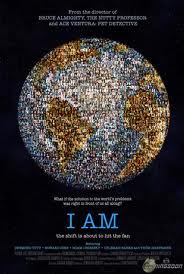 I AM is the 2011 creation of film maker Tom Shadyac, “one of Hollywood’s leading comedy practitioners and the creative force behind such blockbusters as “Ace Ventura,” “Liar Liar,” “The Nutty Professor,” and “Bruce Almighty.”” Shadyac uses the film to explore two questions: what’s wrong with our world, and what can we do to make it better?
I AM is the 2011 creation of film maker Tom Shadyac, “one of Hollywood’s leading comedy practitioners and the creative force behind such blockbusters as “Ace Ventura,” “Liar Liar,” “The Nutty Professor,” and “Bruce Almighty.”” Shadyac uses the film to explore two questions: what’s wrong with our world, and what can we do to make it better?
In the film a series of experts explains that everything in reality is connected and when we don’t honor that truth, things go awry.
Shadyac should stick to comedy. These questions require digging below the surface and thinking at a deeper level. The movie fails at both.
This was truly a disappointing film. I would never show this in my classroom for the following reasons:
1. The film consistently uses non-gender inclusive language. For example “mankind” vs. humankind, “men” instead of men and women or human beings, etc. What was he thinking? Was he thinking?
2. The scientific “experts” in the film are predominantly white males with the exception of one woman and one person of color, Archbishop Desmond TuTu.
3. Positive actions are portrayed by whites. Not so for persons of color. The first clip of a person of color is someone making a negative gesture in traffic, followed by another person of color aggressively picking a fight with someone in the car ahead. Wow, just wow.
4. Systemic aspects of the issues of patriarchy, racism, sexism, or nationalism are never even mentioned, much less addressed. In fact they are subtly promoted. This is done by using white males as “experts,” Obama’s presidency as evidence that the race issue is resolved – it isn’t, or the tragedy of 9/11 as moving the dial in an experiment – but what about the more than 5,000+ women who die every year in the U.S. due to rape, abuse, violence? Why don’t their deaths move the dial?
Basically this is a “warm, fuzzy, feel good” film that stays only on the surface. The economic, educational, taxation and legal systems that continue to transfer wealth to the rich, and rich countries, and keep the poor poor – by design are never discussed or even alluded to.
“I Am” is to systemic injustice what the movie “Crash” was to racism. Individualism is subtly promoted. It is a personal, feel-good message only; if we all just love each other the world will be healed. No. It. Won’t. Systems of injustice need to be dismantled. Laws must be changed.
The viewer is never challenged to think critically about the underlying causes. Perhaps this is because the director himself, a beneficiary of patriarchy and a very privileged background, experiences unearned benefits everyday due to his sex and skin color, to say nothing of his famous father. Who would want to question that?
As you can guess – I don’t recommend this film.
Instead I recommend the film: The Human Experience. You can read why in my write up of it here.

